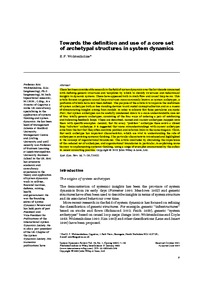Towards the definition and use of a core set of archetypal structures in system dynamicsE. F. Wolstenholme
Erstpublikation in: System Dynamics Review Vol. 19, No 1.
Publikationsdatum:
|
 |
 Zusammenfassungen
Zusammenfassungen
 Die bisher in der Literatur beschriebenen 12 Systemarchetypen werden auf vier Basissystemarchtypen zurück geführt. Für jeden dieser vier Problemarcheypten wird ein entsprechender Lösungsarchetyp vorgestellt, der eine unerwünschte Entwicklung verhindern soll.
Die bisher in der Literatur beschriebenen 12 Systemarchetypen werden auf vier Basissystemarchtypen zurück geführt. Für jeden dieser vier Problemarcheypten wird ein entsprechender Lösungsarchetyp vorgestellt, der eine unerwünschte Entwicklung verhindern soll. Im zweiten Teil des Artikels werden unterschiedliche Gründe besprochen, warum systemisches Denken nicht stattfindet oder keine Konsequenzen hat.
There has been considerable research in the field of system dynamics over the last decade concerned with defining generic structures and templates by which to classify structures and behavioural insights in dynamic systems. These have appeared both in stock/flow and causal loop terms. This article focuses on generic causal loop structures more commonly known as system archetypes, a profusion of which have now been defined. The purpose of the article is to improve the usefulness of system archetypes both as free standing devices to aid model conceptualisation and as a means of disseminating insights arising from models. In order to achieve this three postulates are made:
First, that system archetypes can be usefully condensed down to a more understandable core set of four totally generic archetypes, consisting of the four ways of ordering a pair of reinforcing and balancing feedback loops. These are described, named and current archetypes mapped onto them with specific examples. Second, that for every ‘‘problem’’ archetype there exists a closed loop ‘‘solution’’ archetype. It is suggested that some misunderstandings with current archetypes arise from the fact that they often combine problem and solution links in the same diagram. Third, that each archetype has important characteristics, which are vital to understanding the role of
archetypes in assisting systemic thinking. The particular characteristic introduced and highlighted is the concept of organisational boundaries. The article concludes by discussing the importance of the reduced set of archetypes, and organisational boundaries in particular, in explaining some barriers to implementing systemic thinking, using a range of examples encountered by the author in recent consulting practice.
Von E. F. Wolstenholme im Text Towards the definition and use of a core set of archetypal structures in system dynamics (2003)  Dieser Text erwähnt ...
Dieser Text erwähnt ...
 Dieser Text erwähnt vermutlich nicht ...
Dieser Text erwähnt vermutlich nicht ... 
 Nicht erwähnte Begriffe | Balancing process with delay, Eroding Goals |
 Tagcloud
Tagcloud
 Zitationsgraph
Zitationsgraph
 Zitationsgraph (Beta-Test mit vis.js)
Zitationsgraph (Beta-Test mit vis.js)
 Volltext dieses Dokuments
Volltext dieses Dokuments
 |  Towards the definition and use of a core set of archetypal structures in system dynamics: Artikel als Volltext ( Towards the definition and use of a core set of archetypal structures in system dynamics: Artikel als Volltext ( : :  , 167 kByte; , 167 kByte;  : :  Link unterbrochen? Letzte Überprüfung: 2020-11-28 Letzte erfolgreiche Überprüfung: 2018-11-28) Link unterbrochen? Letzte Überprüfung: 2020-11-28 Letzte erfolgreiche Überprüfung: 2018-11-28) |
 Anderswo suchen
Anderswo suchen 
 Beat und dieser Text
Beat und dieser Text
Beat war Co-Leiter des ICT-Kompetenzzentrums TOP während er Dieser Text ins Biblionetz aufgenommen hat. Die bisher letzte Bearbeitung erfolgte während seiner Zeit am Institut für Medien und Schule. Beat besitzt kein physisches, aber ein digitales Exemplar. Eine digitale Version ist auf dem Internet verfügbar (s.o.). Es gibt bisher nur wenige Objekte im Biblionetz, die dieses Werk zitieren.









 Denken
Denken Fixes that fail
Fixes that fail Limits to Growth
Limits to Growth Management
Management Modelle
Modelle Negative Rückkoppelung
Negative Rückkoppelung Positive Rückkoppelung / Teufelskreis
Positive Rückkoppelung / Teufelskreis Relative Achievement Archetype
Relative Achievement Archetype Relative Control Archetype
Relative Control Archetype Systemarchetypen
Systemarchetypen Underachievement Archetype
Underachievement Archetype


 Biblionetz-History
Biblionetz-History